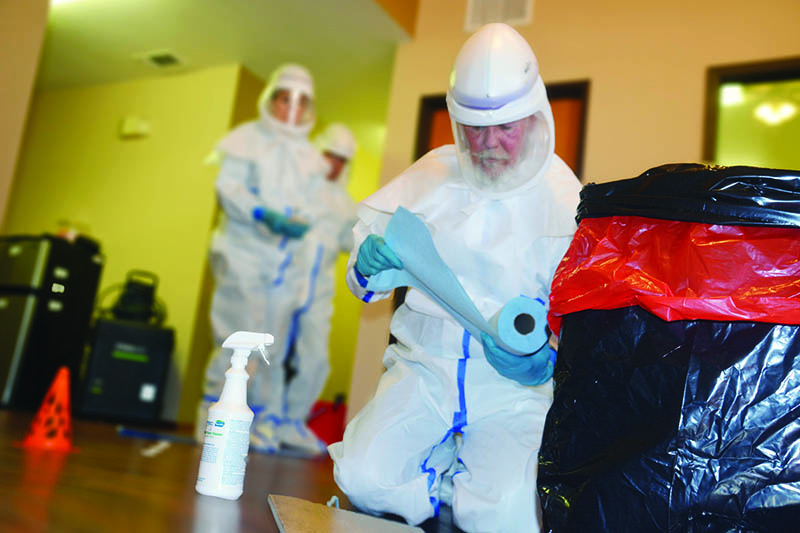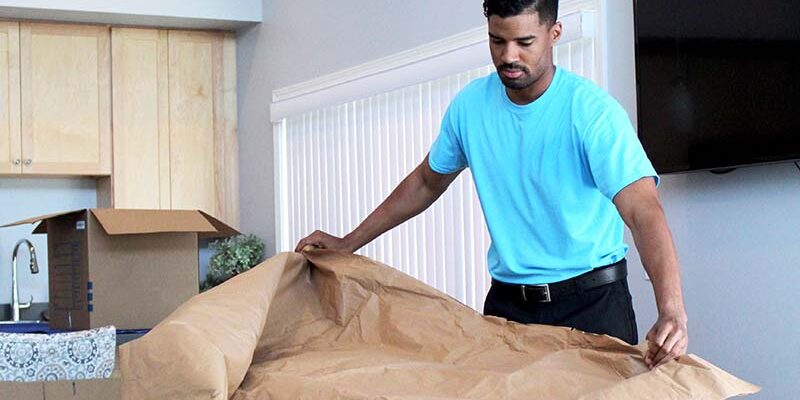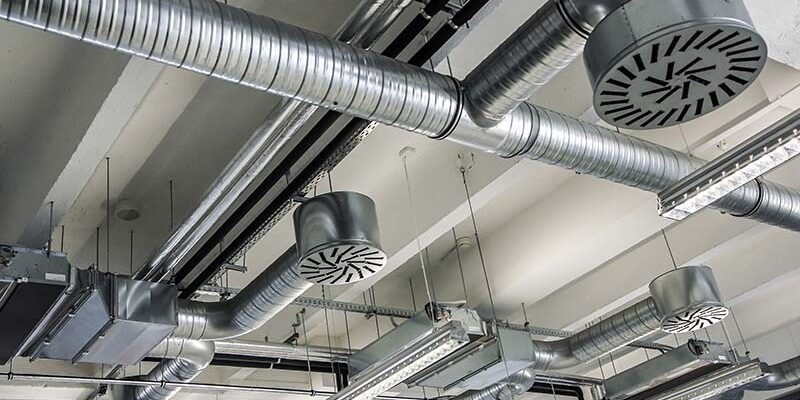Insight on Forensic Restoration

By Jeff Jones and Amanda Hosey
You might have considered adding forensic restoration as a service of your business, and right now is a good time to be in the field because of the current pandemic and its cleanup response. But there is a misconception that forensic restoration is just “crime scene cleaning.” The truth is there is much more to the industry subsect than that.
According to the Global BioRisk Advisory Council (GBAC), “Forensic restoration is a comprehensive remediation of building structures and environments that have been contaminated or suspected to be contaminated by biohazardous materials.” These biohazardous materials could come from incidents of infectious disease, crime and trauma, suicide, unattended death, gross animal fecal contamination, hoarding houses, unsanitary dwellings, etc. The list can go on, but those are some of the primaries.
A day in the life of forensic restoration
Forensic restoration work, like all service work, starts with a phone call. Even if a client inquires about this over the internet, eventually you’re going to make phone contact with someone, so it’s absolutely critical that we try to acquire as much critical incident data as possible: who, what, where, when, and how. That helps us prepare physically, psychologically, and even spiritually for where we’re going and what we’re going to be walking into. It also enables us to get our team properly prepared: Make sure we double check that we’ve got everything—within our vehicles and our mobile support systems—and have all the tools ready when we get out there.
Set up
Once we hit that site, we’re going to be following protocol. We can put different incident sites side by side, and you’ll see how the protocol works on both of them. In one instance, we’re responding to a shotgun suicide. A very graphic scene, this is what a lot of people think about when they think of crime scene cleaning. On the other site, we’re responding to the introduction of a known infectious agent.
On both of these sites, the first thing we are going to do is a site assessment. Here, we look for our safety hazards—the same things that would be involved with traditional restoration. Fire, water, slip and fall potential, electrical hazards, sharps, and anything else that could be a safety hazard needs to be documented.
Zone creation
Next we take our initial ATP readings; we’ll be photographing, logging, and taking measurements. We must document everything. At that time, when we’re establishing the scope of the work, we’ll designate our operations zone, our transition zone, and our clear zone—three distinct zones.
Needless to say, operations is where the actual work is going on. Let’s say for a moment that shotgun suicide happened in a bedroom. That bedroom is going to be the initial operations zone. But make no mistake, whenever a firearm is discharged, there is an incredible amount of energy that’s released. The larger the caliber, the more energy that is released. Things on the biological end have been known to bounce off walls and go down halls, so you’ve got to do your due diligence and establish where your operations zone is. The same is true of the known infectious agent site. If the infectious agent originated in the bedroom, it could be confined to that bedroom, but it also might scope out to be the entire house.
Next is the transition zone where people make the transition from the clear zone to the operations zone. This is where working materials can be place and where donning and doffing can occur before moving to the clear zone. Back in the old days many called the clear zone the “clean zone.” The problem with this characterization is this: I didn’t clean it; you didn’t clean it; so, who cleaned it? We know what the definition of clean is. This area is simply clear of biological materials; it is not clean.
Pre-disinfection and load reduction
The next step on either hypothetical jobsites is to do pre-disinfecting with an EPA-registered, hospital-grade tuberculocidal disinfectant with a six-log kill, proven to kill both gram-negative and gram-positive bacteria and inactivate both enveloped and nonenveloped viruses. We have no illusions about this being able to take care of all the biological threats on site. We do this as a pathogenic knock-down to make this a safer working environment for the team.
At this point, our two scenarios separate a bit. The next step in the protocol is a load reduction. The load reduction is defined as “the removal of all gross amounts of biological contaminants.” That’s pretty easy to figure out on the self-cessation via firearm, but on a tier-four introduction of a known infectious agent, there may not be a gross amount of biological contaminants. So, what do you do? You simply skip that step and go on to the next one because after the load reduction comes detailed forensic cleaning.
Any cleaner worth his weight in salt always asks himself two questions: “What am I cleaning?” and “Why?” Cleaning is defined as, “The removal of soil, both visible and invisible.” Forensic cleaning is defined as, “The removal of biological contaminants, both visible and invisible, to prepare surfaces, both vertical and horizontal, for professional disinfecting.”
Verification
Once forensic cleaning is completed, we take another set of ATP readings, which lets us know our cleanliness level. If we bring those numbers down to single digits, possibly even zero, we know our disinfectant can do what we want it to do. Everything that we’ve done so far—from our pre-disinfection, to our load reduction, to our detailed forensic cleaning and testing—is to set up that final disinfecting. Now we apply an EPA-registered, hospital-grade tuberculocidal disinfectant with a six-log kill, and what we have done is taken a hostile environment and turned it into a user-friendly environment.
Laws and safety
On a forensic restoration site, we’re usually going to be operating under a risk level three, which requires full microporous suits, two sets of nitrile gloves, an exterior set of heavier gloves, booties, respiratory protection, and eye protection. For my team, we always wear powered air purifying respirators (PAPRs) because I want to go one step above to ensure their safety. When people training with GBAC don gear, they wear PAPRs because we try to simulate real world conditions. You’ll be wearing PAPRs if you train with GBAC.
There are regulations for forensic restoration teams as well. Before anyone goes out into the field, they need bloodborne pathogen training. They also must see an occupational medicine specialist to ensure they are physically fit to wear a respirator and must have a respiratory fit test. There is only one respirator I am aware of that requires no fit test. For every other respirator, by law, you have to have one.
Employers must offer employees the option of having a hepatitis B vaccination. If an employee wants the vaccination, the employer is required to pay for that, as well as other regulations that come into play including the disposal of medical waste. These regulations aren’t federal. In fact, these aren’t even made by states. They can vary county to county and municipality to municipality. You have to be aware of where you are working and what you’re going to do with medical waste.
Training and investments
Training for forensic restoration really should be hands on. You can go sit in a classroom and look at a bunch of PowerPoints, or you can go to an environment and try. Kids learn; warriors train. Have no doubt in your mind, this is microbial warfare, so, when we at GBAC conduct training, that’s exactly what we train for. We try to get as close to battlefield conditions as we can.
Trainees actually don and doff PPE. Which is more dangerous? Doffing. You’ve been in a hazardous environment. You’ve got to make sure you don’t contaminate yourself coming out of PPE. That might sound simple, but it’s a common and dangerous mistake. We also go into environments, using real biologicals, and trainees have to follow the protocol to acquire the needed numbers on an ATP test and then be able to professionally disinfect.
Outside of training, the biggest investment for this work is a matter of ensuring the company is stocked with the needed chemicals and delivery systems for them. Let’s go back to the incident site again. What’s the first thing we did? We predisinfected with an EPA-registered, hospital-grade tuberculocidal disinfectant. You need a delivery system for that disinfectant. What’s it going to be? A pump-top sprayer, ULV wet sprayer, electrostatic sprayer, binary-ionization technology with ionized hydrogen peroxide? You have to make your decision.
Some people ask what to disinfect with, to which my reply is, “What’s the incident site?” I never make the decision of what to use. The incident site decides for me.
After that, I’ve got to do a load reduction, and I’ve got to have the tools to be able to do that. The load reduction specialist needs to be the strongest person on the team. That doesn’t necessarily mean he can out bench press anybody. It means he or she should be strong psychologically and spiritually because they’ll be down in the load, removing it, and placing it in containers for proper disposal as medical waste.
What type of tools will you need to do forensic cleaning? Anyone can spray something on a horizontal surface for cleaning and disinfecting, but you must consider how you will get cleaner and disinfectant to adhere to vertical surfaces for proper dwell time. I would highly recommend foamers because foam sticks and will give you that dwell time. There is, of course, special equipment available, but I’ve been doing this for 48 years. Back in the days when we started this (My father did his first one back in 1969.), we didn’t have specialized equipment; we just had cleaning equipment.
Choosing technicians
I can teach forensic cleaning techniques to anyone. That doesn’t mean they’re the right person for this type of work. Everything that we do in this life is always going to be a part of us—from the best Christmas we ever had to the high school breakup when you thought the world was going to end, but somehow it just kept on turning. It’s the same with each and every one of these jobs.
If I wanted to, I could remember every job I’ve ever done in the last 48 years. I don’t because that’s not a balanced way to live. Someone who is grounded and stable is going to be a lot better at this. I’ve met some fine young people who got into this industry, but it’s usually people with a few years behind them, with a few life experiences, and who know why they want to do this. I’ve seen my share of people who thought it was going to be really cool to be a so-called “crime scene cleaner.” They found out really fast there’s nothing cool about this. No one’s calling you because they’re having a good day. In fact, they’re probably having one of the worst days of their lives.
There’s not a classroom or book you can read to prep you for every type of circumstance you’re going to enter into. You’ve got to be like Bruce Lee said, “like water,” and you’ve got to be adaptable and be able to fit under any circumstance.
We don’t get a guidebook for life, so there’s no instruction manual for how to grieve, but in forensic restoration, you will frequently deal with grieving people. I’ve been asked many times, “What should we say to the people?” You are not an ordained minister, pastor, or clergy person. You’re not a licensed psychologist. We are there to perform a service. You want to be a really good conversationalist? Learn how to be a good listener. Don’t try to use 20 words when six will do: “I’m sorry. Let me help you.” That’ll suffice in what we do.
You need to hire people who are balanced and who want to do this work for the right reasons. What you must look for are passionate people who have a desire to be of service. If someone has a warrior’s passion and a servant’s heart, I’ll gladly teach them anything. That’s the type of person who shines in this industry. This is about service, and there is honor in service.
The client
I’ve worked for everyone from insurance companies, to homeowners, to business owners, to government agents on forensic cleaning projects, so the customer expectations can vary greatly from job to job, as can the circumstances. For example, in the case of sites that are involved in a crime scene, you need to make sure the incident site has been released by law enforcement. The last thing you want to do is go in and clean the site for the perpetrator. In a case of a homicide or suicide, if you’re dealing with an insurance company, it’s generally a given that the site has been released, but if you have any doubt, find out. I’ve called local authorities and said, “This is who I am. This is what I do.” Sometimes they have referred me to a detective who confirms it’s been released. It’s not a bother to them, and as a matter of fact, it’s a great line of communication to open up.
A lot of people think we are simply crime scene cleaners or that we are out recovering bio. Here is what we do: We’re biorisk management and infection control specialist, utilizing the techniques of forensic cleaning and professional disinfecting. That’s great; you can put that on a business card.
But let me tell you what we really do. When someone calls us, their world is upside down. Their lives are out of balance. The Navajo word for balance is “hózhó.” The Navajo believe that if a person wants to live a long, healthy, and happy life, it’s essential that they live in hózhó—psychological, physical, and spiritual balance. That balance has been disrupted for our clients, sometimes very violently. What we do is go out and put things back in balance so that people can once again live the nizhóní, the beautiful life.
What we want to do is create a state of perfect balance. That’s really what we do.
Jeff Jones is the director of forensic operations and the master trainer for the Global BioRisk Advisory Council, where he trains industry professionals to be Microbial Warriors. He is an international expert in the development and implementation of forensic restoration best practices. Reach him at [email protected].
Amanda Hosey is the managing editor of Cleanfax. She has worked as an editor and writer for more than six years, including four years with Cleanfax. Reach her at [email protected].












